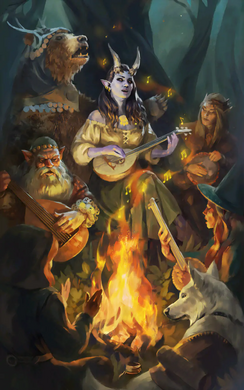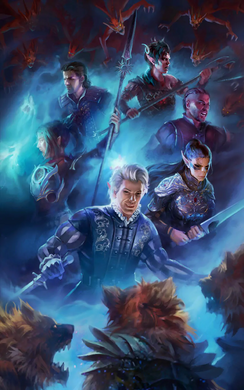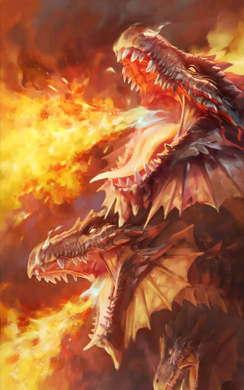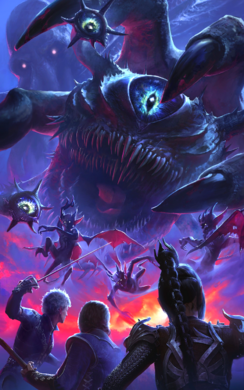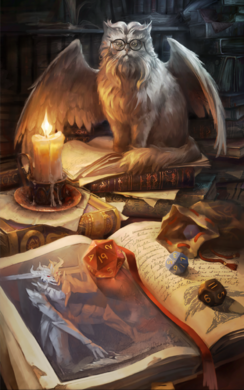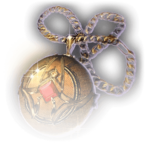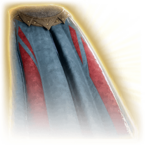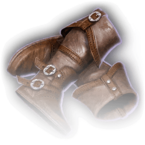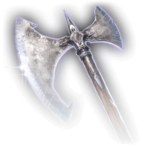Ad placeholder
Gameplay mechanics: Difference between revisions
m (→Proficiency) |
(Added missing navbox) |
||
| (99 intermediate revisions by 16 users not shown) | |||
| Line 1: | Line 1: | ||
== | {{PageSeo | ||
|title = Gameplay mechanics | |||
|description = Baldur's Gate 3 is a turn-based adventure with a wide variety of gameplay mechanics. | |||
}} | |||
'''Baldur's Gate 3''' is a turn-based adventure with a wide variety of '''gameplay mechanics'''. Understanding the core mechanics can help the players navigate the challenging world of Baldurs Gate 3. | |||
This page will give a general overview over the most important aspects, to understand certain nuances, reading linked articles might be required. | |||
Every section has a dedicated wiki page with further information. | |||
== Difficulty == | |||
There are five difficulty settings, or modes: the preset Explorer, Balanced, Tactician and Honour modes – as well Custom mode, which lets the player tweak various gameplay elements. | |||
<gallery mode="packed" heights="260px"> | |||
Explorer Difficulty.webp|Explorer mode | |||
Balanced Difficulty.webp|Balanced mode | |||
Tactician Difficulty.webp|Tactician mode | |||
Honour Difficulty.webp|Honour mode | |||
Custom Difficulty.webp|Custom mode | |||
</gallery> | |||
{{hatnote|Main article: [[Difficulty]].}} | |||
== Combat mechanics == | |||
The combat mechanics in Baldurs Gate 3 evolve around each character and enemy taking ''turns'', based on their initiative roll at the start of combat, reminiscent of Dungeons & Dragons 5th Edition. | |||
=== Turn-based System === | |||
A ''turn'' is the most basic unit of time in ''Baldur's Gate 3'' gameplay. During combat, each creature takes a turn, usually in sequential order. When all creatures have taken their turns, a ''round'' has passed. | |||
When two or more allied creatures are in close proximity to each other and would have otherwise taken their turn immediately after each other, they can usually take their turns at the same time. | |||
While turns are primarily featured in combat, a turn-based mode is also available outside of combat, and automatically turns on in certain scenarios, such as when certain traps are activated. | |||
{{hatnote|Main article: [[Turn-based mode]].}} | |||
==== Turn order ==== | |||
The order in which creatures take their turn (the ''turn order'') is decided by rolling for [[Initiative|initiative]], which is a {{InfoBlob|1d4 + Dex mod}} roll. | |||
{{hatnote|Main article: [[Initiative]].}} | |||
Adjacent creatures in the turn order they share their turn order position and can act interchangeably. For this matter, creatures who are summoned by the player but not controlled by the player, such as the ghouls from the [[Necromancy of Thay]], are not considered to be on the player's side. | |||
: The maximum group size for a shared turn order position is 10 creatures. | |||
If a creature that is attacked is unaware of their attackers at the start of combat, the first round of combat is declared a ''surprise round'', during which only the attackers may take actions. | |||
{{hatnote|Main article: [[Surprised (Condition)|Surprised]].}} | |||
==== Action economy ==== | |||
Most creatures are able to take one {{SmallIcon|Action Icon.png}} Action, one {{SmallIcon|Bonus Action Icon.png}} Bonus Action and one {{SmallIcon|Reaction Icon.png}} Reaction per turn, but some equipment and class features give additional or free actions. | |||
{{hatnote|Main article: [[Actions]].}} | |||
{{hatnote|See also: [[Attacks]].}} | |||
Actions, bonus actions and reactions are also represented as [[Resources|resources]] that are replenished at the start of a creature's turn. For example, when a creature takes an action, their action resource is used. | |||
==== Resources ==== | |||
Most actions require the acting creature to expend one or more resources, usually at least one of the three common resources associated with actions: | |||
{{resource list start}} | |||
{{resource list item | |||
| name = {{SmallIcon|Action Icon.png}} Action | |||
| recharge = turn | |||
| charges = 1 | |||
| type = action | |||
| description = Primary combat resource}} | |||
{{resource list item | |||
| name = {{SmallIcon|Bonus Action Icon.png}} Bonus action | |||
| recharge = turn | |||
| charges = 1 | |||
| type = bonus action | |||
| description = Secondary combat resource}} | |||
{{resource list item | |||
| name = {{SmallIcon|Reaction Icon.png}} Reaction | |||
| recharge = turn | |||
| charges = 1 | |||
| type = reaction | |||
| description = Used to take reactions}} | |||
{{resource list end}}<br>{{hatnote|Main article: [[Resources]].}}<br/> | |||
=== Dice Rolls === | |||
* | Dice rolls are a central game mechanic to determine the outcome of variety of situations, such as whether a character will succeed at using a particular skill, or if an attack will land and how much damage it will do. | ||
** | The base dice are as follows: | ||
{{hlist| | |||
* {{DieIcon|d4|Force}} d4 | |||
* {{DieIcon|d6|Radiant}} d6 | |||
* {{DieIcon|d8|Cold}} d8 | |||
* {{DieIcon|d10|Poison}} d10 | |||
* {{DieIcon|d12|Psychic}} d12 | |||
* {{D20}}}} | |||
Additional modifiers can be applied, which are either bonuses which add to the result, or penalties which are subtracted from it. | |||
{{hatnote|Main article: [[Dice rolls]].}} | |||
==== Advantage ==== | |||
{{Advantage}} and {{Disadvantage}} only apply to {{D20}} rolls for [[Attack Roll]]s, [[Saving Throw]]s, and [[Ability Check]], but never to [[Damage Roll]], greatly affect the outcome of dice rolls. | |||
{{hatnote|Main article: [[Advantage]].}} | |||
=== Attacks === | |||
Attacks are attempts by a [[creatures|creature]] at hitting a target, usually with a [[Weapon|weapon]] or a [[Spells|spell]]. The outcome of an attempted attack is determined by making an ''attack roll'' against the target's [[Armour Class|AC]]. If successful, the attack may deal [[damage]] and/or inflict a [[conditions|condition]]. | |||
<div style="text-align: center;">'''Result = {{InfoBlob|{{D20}} + Ability score modifier + Proficiency bonus}}'''</div> | |||
{{hatnote|Main article: [[Attacks]].}} | |||
==== Critical Hit ==== | |||
Critical hits occur when a creature [[Dice roll|rolls a natural 20]] on an [[attack roll]]. While initially a mechanic subject purely to the whims of luck, a number of features, abilities, and items allow the player to manipulate the odds of scoring a critical hit. | |||
{{hatnote|Main article: [[Critical hit]].}} | |||
== NPCs == | |||
Non-player characters are characters not controlled by the player. They have pre-determined behaviours and defined [[ability score]]s, [[class action]]s, and inventories. | |||
NPCs can be divided into a number of archetypes that are not necessarily mutually exclusive, such as Traders and Bosses. | |||
{{hatnote|Main article: [[Non-player characters]].}} | |||
== Player Character == | |||
When starting the game, the player is prompted to create their own character. The character can be fully customized or be choosen from the [[Origin]] characters. | |||
{{hatnote|Main article: [[Character creation]].}} | |||
=== Classes === | |||
A character's class in Baldur's Gate 3 is one of their primary defining features. Each class represents a different calling, and each offers a number of unique abilities, powers, and skills that influence how that character interacts with the world. | |||
<center> | |||
<gallery widths="130px" perrow="6" mode="nolines"> | |||
Class Barbarian Badge Icon.png|[[Barbarian]]|link=Barbarian | |||
Class Bard Badge Icon.png|[[Bard]]|link=Bard | |||
Class Cleric Badge Icon.png|[[Cleric]]|link=Cleric | |||
Class Druid Badge Icon.png|[[Druid]]|link=Druid | |||
Class Fighter Badge Icon.png|[[Fighter]]|link=Fighter | |||
Class Monk Badge Icon.png|[[Monk]]|link=Monk | |||
Class Paladin Badge Icon.png|[[Paladin]]|link=Paladin | |||
Class Ranger Badge Icon.png|[[Ranger]]|link=Ranger | |||
Class Rogue Badge Icon.png|[[Rogue]]|link=Rogue | |||
Class Sorcerer Badge Icon.png|[[Sorcerer]]|link=Sorcerer | |||
Class Warlock Badge Icon.png|[[Warlock]]|link=Warlock | |||
Class Wizard Badge Icon.png|[[Wizard]]|link=Wizard | |||
</gallery></center> | |||
Player characters and all companions also have a [[Background|background]], [[Race|race]] and can use [[Equipment|equipment]]. Having levels in a class allows access to ''class features'', which are the features that set classes apart from each other. | |||
The [[Character level]] can be increased by gaining [[Experience]], characters start at 0 experience and can gain up to 100,000 experience, which is the experience required to reach level 12. | |||
Classes may also grant access to [[Spells|spells]] and [[Feats|feats]]. | |||
{{hatnote|Main article: [[Classes]].}} | |||
=== Spellcasting === | |||
While all classes are capable of casting spells, some classes are proficient in spellcasting, and automatically learn spells. These classes may cast these learned spells using ''spell slots''. | |||
Every class – including those without the Spellcasting feature – has a designated [[Ability scores|ability]] known as their ''spellcasting ability'' | |||
{{table list| | |||
; {{Ability|Intelligence}} : [[Fighter]], [[Rogue]], [[Wizard]]. | |||
; {{Ability|Wisdom}} : [[Cleric]], [[Druid]], [[Monk]], [[Ranger]]. | |||
; {{Ability|Charisma}} : [[Barbarian]], [[Bard]], [[Paladin]], [[Sorcerer]], [[Warlock]]. | |||
}} | |||
Spells are created from the Weave, the magical energies of the multiverse. They are conjured through experience, knowledge, or innate ability, or via the use of scrolls and magical items. | |||
{{hatnote|Main article: [[Spellcasting]].}} | |||
=== Stats === | |||
** [[ | Every creature has a set of basic statistics: | ||
[[File:HP Icon.png|frameless|left|40px]] | |||
Hit points (or HP), given in numbers, represent a creature's life force, or an object's structural integrity. They indicate how much damage you or a party member can take before being [[Downed_(Condition)|Downed]], and how much damage creatures and items can take before being killed or destroyed. | |||
{{hatnote|Main article: [[Hit points]].}} | |||
[[File:16 Armor Class Icon.png|frameless|left|40px]] | |||
Armour Class (AC) is a measurement of how difficult a creature is to be hit by an attack. AC can be increased by equipping [[Armour|armour]] and [[Shields|shields]], by selecting certain [[Feats|feats]] when leveling up, or utilizing certain [[Spells|spells]]. | |||
{{hatnote|Main article: [[Armour Class]].}} | |||
[[File:Creature Size Icon.png|frameless|left|40px]] | |||
A [[Creatures|creature's]] size indicates how large it is, roughly communicating other parameters like the model's dimensions/how much space it physically occupies. The weight of a creature affects what can [[Throw]] or [[Shove]] it. | |||
{{hatnote|Main article: [[Creature size]].}} | |||
[[File:Fast Movement Icon.png|frameless|left|40px]] | |||
Movement speed determines how far a creature can move on its turn, on a 1:1 ratio. A creature's [[race]] determines whether their default movement speed is ''slow'', ''normal'' or ''fast'': | |||
* Slow: {{distance|m=7.5|ft=25}} | |||
* Normal: {{distance|m=9|ft=30}} | |||
* Fast: {{distance|m=10.5|ft=35}} | |||
{{hatnote|Main article: [[Resources#Movement_speed|Movement Speed]].}} | |||
=== Resistances === | |||
This applies to both player characters and NPCs. Resistances represent a creature's capacity to withstand certain [[Damage#Damage types|types of damage]]. | |||
''Vulnerability'', ''resistance'', and ''immunity'' are properties that modify how much damage a target takes from specific types of damage: | |||
<gallery mode=nolines heights=40px> | |||
Bludgeoning Damage Icon.png|{{DamageColor|Bludgeoning|Bludgeoning}} | |||
Piercing Damage Icon.png|{{DamageColor|Piercing|Piercing}} | |||
Slashing Damage Icon.png|{{DamageColor|Slashing|Slashing}} | |||
Acid Damage Icon.png|{{DamageColor|Acid|Acid}} | |||
Cold Damage Icon.png|{{DamageColor|Cold|Cold}} | |||
Fire Damage Icon.png|{{DamageColor|Fire|Fire}} | |||
Force Damage Icon.png|{{DamageColor|Force|Force}} | |||
Lightning Damage Icon.png|{{DamageColor|Lightning|Lightning}} | |||
Necrotic Damage Icon.png|{{DamageColor|Necrotic|Necrotic}} | |||
Poison Damage Icon.png|{{DamageColor|Poison|Poison}} | |||
Psychic Damage Icon.png|{{DamageColor|Psychic|Psychic}} | |||
Radiant Damage Icon.png|{{DamageColor|Radiant|Radiant}} | |||
Thunder Damage Icon.png|{{DamageColor|Thunder|Thunder}} | |||
</gallery> | |||
{{hatnote|Main article: [[Resistances]].}} | |||
=== Conditions === | |||
Conditions are changes in a character's status, both beneficial and harmful. They can be inflicted by certain [[Spells]], class features, [[surface]]s and other environmental hazards. Many conditions are temporary, and some can also be removed with the right spell or potion. | |||
{{hatnote|Main article: [[Conditions]].}} | |||
== Equipment == | |||
Equipment are important items for the player’s adventure. They can be weapons that deal damage to enemies, or armour for protection from them. They can also give interesting bonuses to the player’s characters such as extra spells, special enchantments, and so on. | |||
Detailed information on each type of equipment can be found right below or in the main article: | |||
<gallery heights="97px" mode="packed"> | |||
Keepsake_Locket_A_Faded.png|[[Amulets]]|link=Amulets | |||
Padded Armour Icon.png|[[Armour]]|link=Armour | |||
Cloak_Of_Protection_Icon.png|[[Cloaks]]|link=Cloaks | |||
Simple_Robe_Icon.png|[[Clothing]]|link=Clothing | |||
Leather_Boots_Icon.png|[[Footwear]]|link=Footwear | |||
Metallic_Gloves_Icon.png|[[Handwear]]|link=Handwear | |||
Circlet of Fire Icon.png|[[Headwear]]|link=Headwear | |||
Crushers_Ring_Icon.png|[[Rings]]|link=Rings | |||
Studded_Shield_Icon.png|[[Shields]]|link=Shields | |||
Greataxe_Icon.png|[[Weapon]]s|link=Weapon | |||
</gallery> | |||
{{hatnote|Main article: [[Equipment]].}} | |||
{{NavGameplay}} | |||
[[Category:Gameplay mechanics]] | |||
Latest revision as of 13:25, 5 September 2024
Baldur's Gate 3 is a turn-based adventure with a wide variety of gameplay mechanics. Understanding the core mechanics can help the players navigate the challenging world of Baldurs Gate 3.
This page will give a general overview over the most important aspects, to understand certain nuances, reading linked articles might be required. Every section has a dedicated wiki page with further information.
Difficulty[edit | edit source]
There are five difficulty settings, or modes: the preset Explorer, Balanced, Tactician and Honour modes – as well Custom mode, which lets the player tweak various gameplay elements.
Combat mechanics[edit | edit source]
The combat mechanics in Baldurs Gate 3 evolve around each character and enemy taking turns, based on their initiative roll at the start of combat, reminiscent of Dungeons & Dragons 5th Edition.
Turn-based System[edit | edit source]
A turn is the most basic unit of time in Baldur's Gate 3 gameplay. During combat, each creature takes a turn, usually in sequential order. When all creatures have taken their turns, a round has passed.
When two or more allied creatures are in close proximity to each other and would have otherwise taken their turn immediately after each other, they can usually take their turns at the same time.
While turns are primarily featured in combat, a turn-based mode is also available outside of combat, and automatically turns on in certain scenarios, such as when certain traps are activated.
Turn order[edit | edit source]
The order in which creatures take their turn (the turn order) is decided by rolling for initiative, which is a 1d4 + Dex mod roll.
Adjacent creatures in the turn order they share their turn order position and can act interchangeably. For this matter, creatures who are summoned by the player but not controlled by the player, such as the ghouls from the Necromancy of Thay, are not considered to be on the player's side.
- The maximum group size for a shared turn order position is 10 creatures.
If a creature that is attacked is unaware of their attackers at the start of combat, the first round of combat is declared a surprise round, during which only the attackers may take actions.
Action economy[edit | edit source]
Most creatures are able to take one ![]() Action, one
Action, one ![]() Bonus Action and one
Bonus Action and one ![]() Reaction per turn, but some equipment and class features give additional or free actions.
Reaction per turn, but some equipment and class features give additional or free actions.
Actions, bonus actions and reactions are also represented as resources that are replenished at the start of a creature's turn. For example, when a creature takes an action, their action resource is used.
Resources[edit | edit source]
Most actions require the acting creature to expend one or more resources, usually at least one of the three common resources associated with actions:
 Action
Action Recharge: turn (1 action)
Recharge: turn (1 action)
- Primary combat resource
 Bonus action
Bonus action Recharge: turn (1 bonus action)
Recharge: turn (1 bonus action)
- Secondary combat resource
 Reaction
Reaction Recharge: turn (1 reaction)
Recharge: turn (1 reaction)
- Used to take reactions
Dice Rolls[edit | edit source]
Dice rolls are a central game mechanic to determine the outcome of variety of situations, such as whether a character will succeed at using a particular skill, or if an attack will land and how much damage it will do. The base dice are as follows:
 d4
d4 d6
d6 d8
d8 d10
d10 d12
d12 d20
d20
Additional modifiers can be applied, which are either bonuses which add to the result, or penalties which are subtracted from it.
Advantage[edit | edit source]
![]() Advantage and
Advantage and ![]() Disadvantage only apply to
Disadvantage only apply to ![]() d20 rolls for Attack Rolls, Saving Throws, and Ability Check, but never to Damage Roll, greatly affect the outcome of dice rolls.
d20 rolls for Attack Rolls, Saving Throws, and Ability Check, but never to Damage Roll, greatly affect the outcome of dice rolls.
Attacks[edit | edit source]
Attacks are attempts by a creature at hitting a target, usually with a weapon or a spell. The outcome of an attempted attack is determined by making an attack roll against the target's AC. If successful, the attack may deal damage and/or inflict a condition.
Critical Hit[edit | edit source]
Critical hits occur when a creature rolls a natural 20 on an attack roll. While initially a mechanic subject purely to the whims of luck, a number of features, abilities, and items allow the player to manipulate the odds of scoring a critical hit.
NPCs[edit | edit source]
Non-player characters are characters not controlled by the player. They have pre-determined behaviours and defined ability scores, class actions, and inventories. NPCs can be divided into a number of archetypes that are not necessarily mutually exclusive, such as Traders and Bosses.
Player Character[edit | edit source]
When starting the game, the player is prompted to create their own character. The character can be fully customized or be choosen from the Origin characters.
Classes[edit | edit source]
A character's class in Baldur's Gate 3 is one of their primary defining features. Each class represents a different calling, and each offers a number of unique abilities, powers, and skills that influence how that character interacts with the world.
Player characters and all companions also have a background, race and can use equipment. Having levels in a class allows access to class features, which are the features that set classes apart from each other.
The Character level can be increased by gaining Experience, characters start at 0 experience and can gain up to 100,000 experience, which is the experience required to reach level 12.
Classes may also grant access to spells and feats.
Spellcasting[edit | edit source]
While all classes are capable of casting spells, some classes are proficient in spellcasting, and automatically learn spells. These classes may cast these learned spells using spell slots.
Every class – including those without the Spellcasting feature – has a designated ability known as their spellcasting ability
Spells are created from the Weave, the magical energies of the multiverse. They are conjured through experience, knowledge, or innate ability, or via the use of scrolls and magical items.
Stats[edit | edit source]
Every creature has a set of basic statistics:
Hit points (or HP), given in numbers, represent a creature's life force, or an object's structural integrity. They indicate how much damage you or a party member can take before being Downed, and how much damage creatures and items can take before being killed or destroyed.
Armour Class (AC) is a measurement of how difficult a creature is to be hit by an attack. AC can be increased by equipping armour and shields, by selecting certain feats when leveling up, or utilizing certain spells.
A creature's size indicates how large it is, roughly communicating other parameters like the model's dimensions/how much space it physically occupies. The weight of a creature affects what can Throw or Shove it.
Movement speed determines how far a creature can move on its turn, on a 1:1 ratio. A creature's race determines whether their default movement speed is slow, normal or fast:
- Slow:
 7.5 m / 25 ft
7.5 m / 25 ft - Normal:
 9 m / 30 ft
9 m / 30 ft - Fast:
 10.5 m / 35 ft
10.5 m / 35 ft
Resistances[edit | edit source]
This applies to both player characters and NPCs. Resistances represent a creature's capacity to withstand certain types of damage.
Vulnerability, resistance, and immunity are properties that modify how much damage a target takes from specific types of damage:
Conditions[edit | edit source]
Conditions are changes in a character's status, both beneficial and harmful. They can be inflicted by certain Spells, class features, surfaces and other environmental hazards. Many conditions are temporary, and some can also be removed with the right spell or potion.
Equipment[edit | edit source]
Equipment are important items for the player’s adventure. They can be weapons that deal damage to enemies, or armour for protection from them. They can also give interesting bonuses to the player’s characters such as extra spells, special enchantments, and so on.
Detailed information on each type of equipment can be found right below or in the main article:
